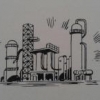I totally agree with Breizh's experienced advice. This type of operation deserves nothing less than a detailed, safe visual AND instrument documented inspection - ON A ROUTINE BASIS. These factors and plans should be established by and through a production department safety meeting - including both operators and engineers - that agrees on the appropriate hazards identification and the inherent risks to be taken when visual inspection with vessel entry are not employed to establish the true, verifiable physical state of the vessels in question.
When it comes to trusting the predicted corrosiveness of sulfuric acid and caustic soda, I would not operate more than a year with such vessels without a thorough visual inspection and gauging - all to be kept in the engineering files and monitored yearly as to corrosion rate and documented physical state of the respective vessels. These are chemicals that allow your operators no level of safety once they develop a rupture or leak. Unexpected or accidental spillage from these chemicals can be a deadly and tragic occurrence. If you fail to take ALL the available safe steps to safeguard your operators, any exposure to these chemicals cannot be shrugged off as an "accident". I would consider that shoddy and careless plant engineering and a direct cause to any tragic results.
I would not rely on general codes or recommended inspections by others - who have no responsibility for any consequences. I would establish my own safety concerns and standards to secure a safe and reliable system with these chemicals. I would also ensure that all members of the production team and force are participants and shareholders in ensuring that the established safety procedures and precautions are religiously followed. In the final analysis in the event of a tragic occurrence it is the engineering and managerial staff that are (and should be) held responsible for the event. NACE, ASME, nor anyone else will respond or assume responsibility.

 FB
FB












